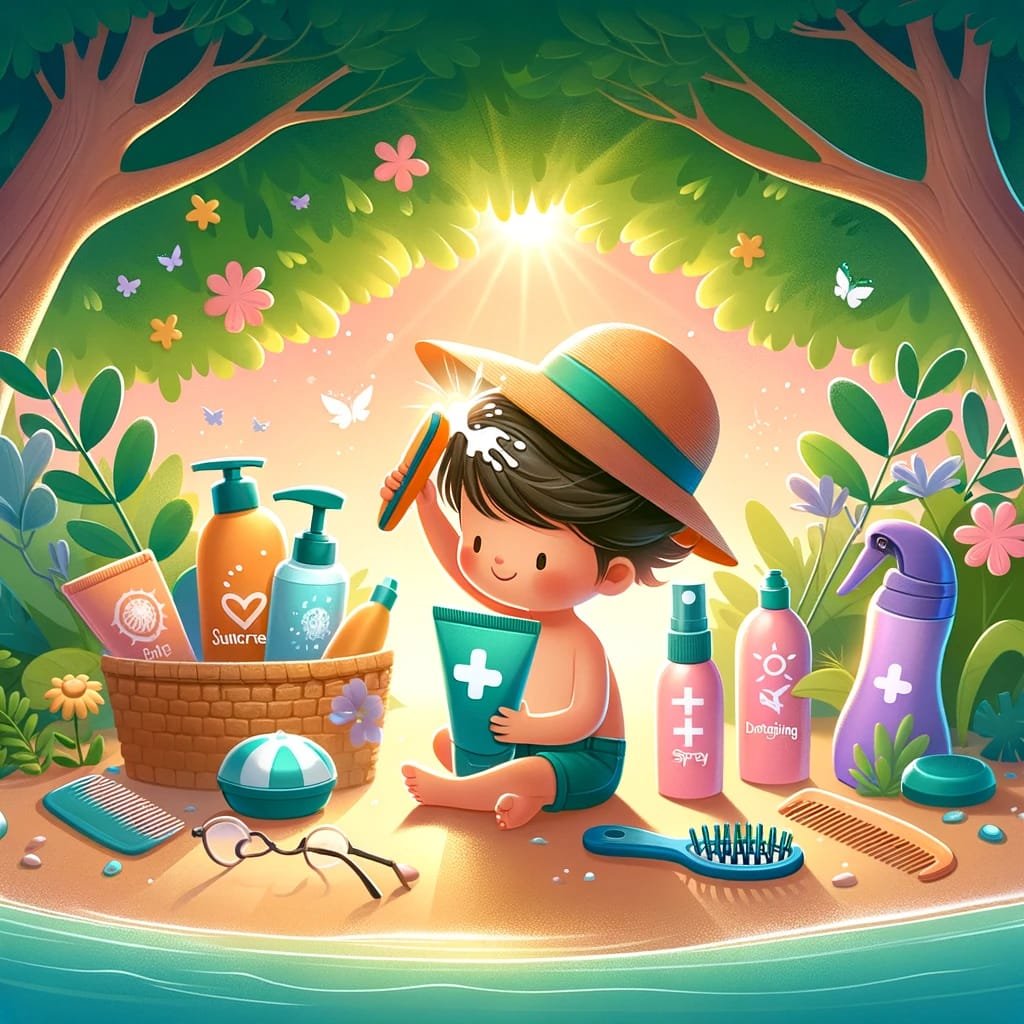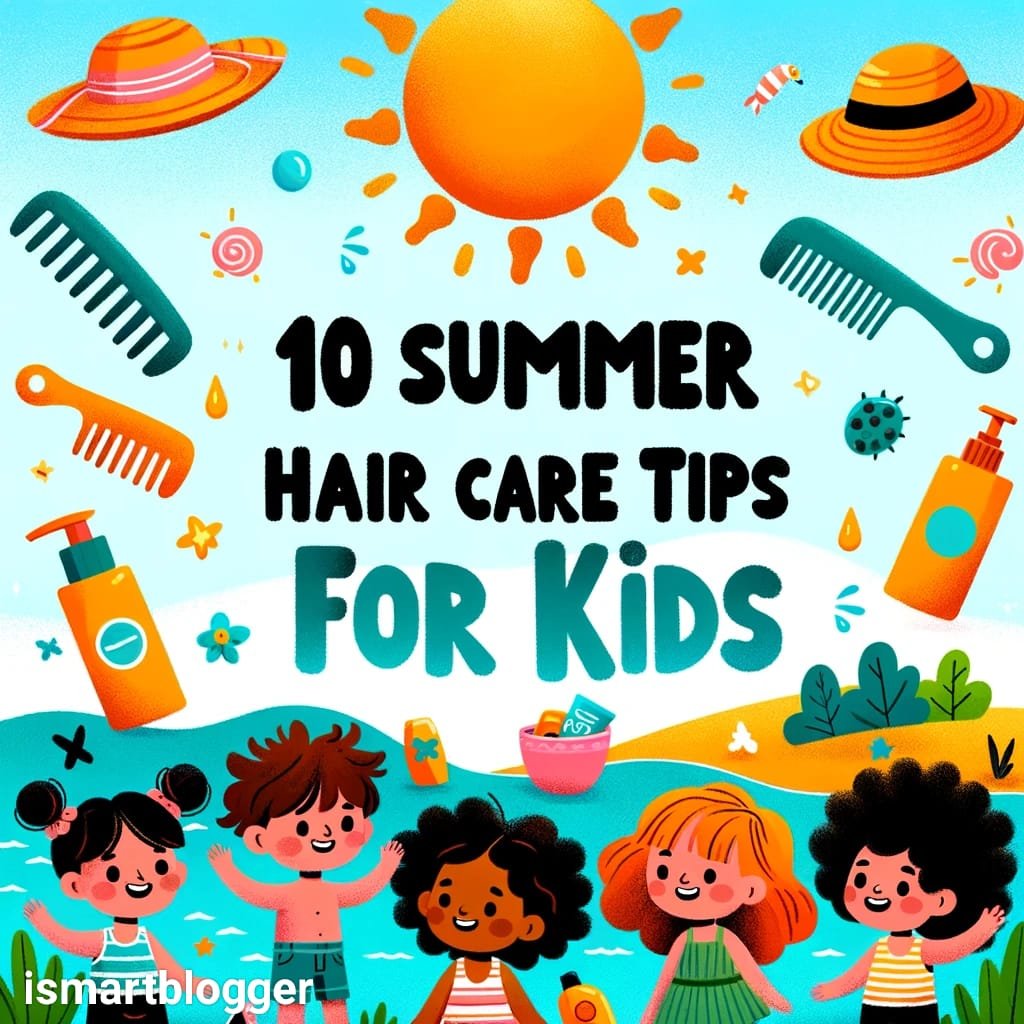Introduction
The summer season brings with it a myriad of joys for children – long days filled with outdoor adventures, swimming in pools, building sandcastles at the beach, and enjoying ice cream under the warm sun. However, as parents, we must also acknowledge the potential impact of summer on our little ones’ hair health.
The combination of heat, humidity, exposure to UV rays, and activities can take a toll on their delicate strands. Hence, it becomes crucial to implement effective summer hair care routines to ensure their locks remain healthy and lustrous throughout this vibrant season.
Importance of Summer Hair Care for Kids
Proper summer hair care is essential for children as their scalps tend to be more sensitive and their hair more prone to damage than adults. The increased exposure to harsh environmental elements during this season makes it necessary to adopt specific strategies that protect and nourish their tresses. Neglecting hair care can lead to various issues such as dryness, frizziness, breakage, scalp irritation, or sunburn – all of which can affect not only the appearance but also the overall well-being of your child.
To help parents navigate this often-overlooked aspect of summer grooming for kids’ hair properly, we present ten invaluable tips that will aid in maintaining healthy locks despite the many challenges that come with summertime activities. Incorporating these tips into your child’s routine will not only help them keep their mane looking fabulous but also contribute to overall scalp health and confidence.

Overview of 10 Tips to Maintain Healthy Hair During Summer
To ensure comprehensive coverage of all aspects of kids’ summer hair care needs, we have compiled ten expert tips designed specifically for this purpose:
- Regular Shampooing and Conditioning
- Protecting Hair from Sun Damage
- Hydrating Hair with Moisturizing Products
- Avoiding Chlorine Damage
- Preventing Frizz and Tangles
- Minimizing Heat Styling
- Maintaining a Healthy Diet
- Safeguarding Hair during Outdoor Activities
- Promoting Scalp Health and Circulation
- Scheduling Regular Trims and Check-ups
This comprehensive list encompasses various aspects of summer hair care that parents should consider to ensure their children’s locks remain resilient, healthy, and beautiful throughout the season. Each tip will be discussed in detail in subsequent sections, providing valuable insights on best practices, recommended products, and necessary precautions to take. By following these expert recommendations, parents can equip themselves with the knowledge needed to tackle any hair-related challenges that may arise.
Understanding the Basics
Hair Structure and Growth Cycle in Children
When it comes to understanding the basics of hair care for kids, it is crucial to have a grasp of their unique hair structure and growth cycle. The hair shaft, composed of the protein keratin, consists of three layers: the cuticle, cortex, and medulla.
In children, the cuticle layer is generally thinner and more delicate compared to adults. This makes their hair more prone to damage from external factors such as sun exposure, chlorine, and excessive heat styling.
The growth cycle of children’s hair differs slightly from that of adults. It goes through three phases: anagen (growth), catagen (transition), and telogen (resting).
The anagen phase is particularly important as it determines the length and strength of the hair. During summer months when kids are exposed to prolonged sunlight and increased physical activity, their hair growth may be affected due to factors like dehydration or vitamin deficiencies.
Factors That Affect Hair Health in Summer
Summer can be a challenging season for maintaining healthy locks in children due to various factors that can negatively impact their hair health. Excessive heat from direct sunlight can lead to dehydration not only for their bodies but also for their scalps. Dehydration can cause dryness and brittleness in the hair shafts, making them more susceptible to breakage.
Additionally, increased outdoor activities during summer expose children’s hair to environmental pollutants like dust, dirt, and sweat accumulation on the scalp. These impurities can clog pores which might hinder new hair growth or even lead to scalp infections if not addressed properly.
Moreover, frequent swimming in chlorinated pools is another factor that affects children’s hair health during summer. Chlorine strips away natural oils from the scalp and weakens the hair strands over time if protective measures are not taken.
Therefore, understanding the hair structure and growth cycle in children, as well as the factors that affect their hair health during summer, lays a solid foundation for implementing effective hair care practices. By being aware of these fundamental aspects, parents and caregivers can take appropriate measures to protect and nourish their children’s hair throughout the season.
Tip 1: Regular Shampooing and Conditioning
Importance of using mild, kid-friendly shampoos
When it comes to maintaining healthy hair during the summer, using mild and kid-friendly shampoos is paramount. Children’s hair is typically more delicate and sensitive compared to adults, making it crucial to choose products that are gentle and free from harsh chemicals.
Opting for shampoos specifically formulated for kids ensures that their scalps remain nourished and their hair stays healthy. Mild shampoos are designed to cleanse the hair without stripping away essential oils and moisture.
They contain gentle surfactants that effectively remove dirt, sweat, and product buildup while protecting the natural balance of the scalp. Additionally, these kid-friendly formulations often boast added benefits such as detangling properties or soothing ingredients like aloe vera or chamomile.
Frequency of washing based on hair type and activity level
Determining how often children should wash their hair during summer depends on various factors including their hair type and activity level. Generally, children with oily hair may need more frequent washing as excess sebum production can lead to a greasy appearance. On the other hand, children with dry or curly hair should avoid excessive washing as it can strip away natural oils, resulting in frizz or increased dryness.
It is advisable to shampoo children’s hair at least twice a week during summer unless they engage in activities that make them excessively sweaty or dirty (like swimming or playing sports). In such cases, immediate cleansing becomes crucial to prevent bacterial growth on the scalp.
However, remember that excessive washing can also lead to dryness and scalp irritation; hence finding the right balance is key. By adjusting the frequency of shampooing based on individual needs while using mild products appropriate for children’s delicate scalps, parents can ensure proper cleanliness without compromising essential moisture levels in their little ones’ hair.
Overall, regular shampooing and conditioning are vital components of summer hair care for kids. By choosing mild, kid-friendly shampoos and adjusting the frequency of washing based on hair type and activity level, parents can maintain optimal scalp health while keeping their children’s locks clean and fresh throughout the sunny season.
Tip 2: Protecting Hair from Sun Damage
UV rays’ harmful effects on hair
The scorching summer sun not only affects our skin but also takes a toll on our hair. The ultraviolet (UV) radiation in sunlight can cause significant damage to the hair shaft, leading to dryness, brittleness, and even color fading.
Prolonged exposure to UV rays can weaken the protein structure of the hair strands, resulting in increased porosity and vulnerability to breakage. Furthermore, UV radiation can also deplete the natural oils present in the scalp, making the hair more prone to frizz and roughness.
Using hats, scarves, or UV-protective sprays to shield hair
To shield your child’s delicate tresses from harmful UV rays during summer days spent outdoors, there are several effective methods you can employ. Encouraging your child to wear a wide-brimmed hat or a lightweight scarf not only adds a fashionable touch but also provides valuable protection against sun damage.
These accessories create a physical barrier between the sun’s rays and your child’s hair, minimizing direct exposure. Additionally, using specially formulated UV-protective sprays or leave-in conditioners can significantly aid in safeguarding your child’s precious locks from harmful radiation.
These products typically contain ingredients like sunscreen filters or natural botanical extracts with antioxidant properties that help neutralize free radicals caused by UV exposure. When applying such sprays or leave-in conditioners, be sure to distribute them evenly through damp or dry hair before venturing outside for maximum effectiveness.
Remember that protecting your child’s hair from sun damage should be a part of their daily routine throughout the summer months. By taking these proactive steps to shield your locks from harmful UV rays, you can maintain your hair’s health and ensure it remains radiant and vibrant throughout this sunny season.
Tip 3: Hydrating Hair with Moisturizing Products
Benefits of moisturizing conditioners and leave-in treatments
One of the key aspects of summer hair care for kids is ensuring adequate hydration. Moisturizing conditioners and leave-in treatments can be immensely beneficial in this regard.
These products are specifically formulated to replenish moisture, nourish the hair strands, and restore their natural shine. Regular use of moisturizing conditioners helps to prevent dryness, frizz, and brittleness caused by exposure to heat, sun, and saltwater.
Moisturizing conditioners contain essential ingredients like humectants, emollients, and natural oils that work together to lock in moisture and improve the hair’s elasticity. Humectants such as glycerin attract moisture from the air into the hair shafts, preventing them from becoming dry or dehydrated.
Emollients like shea butter or coconut oil help to smooth the cuticles and make the hair more manageable. Natural oils such as argan oil or jojoba oil provide deep nourishment to the hair follicles, promoting healthier growth.
In addition to moisturizing conditioners, leave-in treatments offer an extra layer of hydration throughout the day. These lightweight formulations are designed to be left in the hair after washing or styling without rinsing out.
They provide ongoing moisture replenishment while offering protection against environmental stressors like UV rays and pollution. By incorporating both moisturizing conditioners and leave-in treatments into your child’s summer hair care routine, you can ensure their locks remain hydrated and vibrant even in hot weather conditions.
Choosing products with natural ingredients for added nourishment
When selecting moisturizing products for your child’s summer hair care regimen, it is advisable to choose those with natural ingredients for added nourishment. Natural ingredients are less likely to irritate, making them suitable for children with sensitive scalps.
Furthermore, these ingredients often possess inherent properties that benefit the hair’s health and appearance. Look for products that contain natural moisturizers like aloe vera, honey, or vegetable glycerin.
Aloe vera is known for its soothing and hydrating properties, while honey acts as a humectant and helps to retain moisture in the hair shafts. Vegetable glycerin also serves as an excellent humectant, attracting moisture from the environment to keep the hair hydrated.
Additionally, seek out products enriched with nourishing natural oils such as argan oil, coconut oil, or jojoba oil. These oils are rich in vitamins, antioxidants, and fatty acids that provide deep conditioning benefits.
They help repair damaged hair strands while improving overall hair texture and shine. By opting for moisturizing products with natural ingredients specifically catered to your child’s needs, you can ensure their hair receives optimal hydration and nourishment during the summer months.
Tip 4: Avoiding Chlorine Damage
The Impact of Chlorine on Hair Health
Chlorine, commonly found in swimming pools, can have detrimental effects on the health and appearance of children’s hair. The chemical composition of chlorine strips the hair of its natural oils, leading to dryness, brittleness, and increased porosity. This can result in hair breakage, split ends, and a dull appearance.
Additionally, chlorine can cause hair discoloration or green tint, especially for light-colored or blonde hair. Parents need to understand the potential dangers so they can take necessary precautions to protect their children’s precious locks.
Protection Measures like Pre-Wetting and Using Swim Caps or Protective Sprays
To minimize the damage caused by chlorine exposure during swimming sessions, a few preventive measures can be implemented: 1. Pre-wetting: Before entering the pool, encourage your child to wet their hair thoroughly with non-chlorinated water.
Saturating the hair with clean water first creates a barrier that limits the amount of chlorinated water absorbed by the strands. 2. Swim caps: Invest in high-quality swim caps made from silicone or latex materials that provide an extra layer of protection against chlorine exposure.
Ensure that it covers both the scalp and all strands of hair to prevent direct contact with chlorinated water. 3. Protective sprays: Another option is using protective sprays specifically designed to shield the hair from chlorine damage.
These sprays contain ingredients like keratin or coconut oil that create a temporary barrier against chlorinated water while providing hydration to keep the hair moisturized. These protection measures will significantly reduce the harmful effects of chlorine on your child’s delicate tresses and help maintain healthy-looking locks throughout summer swimming activities.
Tip 5: Preventing Frizz and Tangles
The Battle Against Frizz and Tangles in Summer
Summer is a season filled with sunshine, beach trips, and outdoor adventures for kids. However, it also brings the challenge of dealing with frizz and tangles in their hair. The combination of heat, humidity, and exposure to elements like saltwater or chlorine can wreak havoc on even the most well-behaved locks.
Understanding the causes of frizz and tangles during summer will help you take effective preventive measures. Frizz occurs when the hair cuticle is lifted due to moisture in the air.
This causes individual strands to become rough, creating a frizzy appearance. Humidity exacerbates this effect as it penetrates the hair shaft, causing it to swell and lose its natural smoothness.
Tangles are another common issue during summer due to increased outdoor activities that expose children’s hair to wind, sand, or water. When hair becomes dry or damaged from environmental factors combined with insufficient moisture content, it becomes prone to tangling.
Gentle Detangling Techniques for Healthy Hair
Detangling your child’s hair without causing breakage can be a daunting task but rest assured there are effective techniques that can help you achieve this mission without tears or frustration. Here are some valuable tips for gentle detangling: 1. Start by spraying a leave-in conditioner or detangler on damp hair: This will provide lubrication and reduce friction while combing through knots.
Use your fingers initially to loosen any larger tangles before using a wide-toothed comb or a brush specifically designed for wet hair. 2. Divide the hair into sections: Working section by section is beneficial as it allows you to focus on one area at a time instead of trying to manage all the tangles at once.
Begin detangling from the ends of each section, gradually working your way up to the roots. This approach prevents unnecessary strain on the hair shaft and minimizes breakage.
3. Use a detangling spray or homemade solution: If your child’s hair tends to tangle easily, consider using a leave-in detangler spray or create your solution by mixing the conditioner with water in a spray bottle. Apply this mixture generously to damp hair before starting the detangling process.
Remember, patience is key when dealing with tangles. Rushing through the process can lead to more damage and discomfort for your child.
Take breaks if needed and be gentle, using slow and deliberate movements while detangling. With consistent care, you can maintain healthy, tangle-free locks throughout the summer and beyond.
Tip 6: Minimizing Heat Styling
The Damaging Effects of Excessive Heat Styling
Heat styling tools such as flat irons, curling irons, and blow dryers have become popular for achieving various hairstyles. However, excessive use of these tools can wreak havoc on your child’s hair during the summer. The high temperatures can strip the hair of its natural moisture, leaving it dry, brittle, and prone to breakage.
Additionally, heat styling can lead to split ends and frizz, making it difficult to maintain healthy-looking hair. When the sun is already causing damage to the hair by drying it out, using heat styling tools only exacerbates the problem.
The combination of intense heat from both sources can result in irreversible damage over time. It’s crucial to educate your child about the potential consequences of excessive heat styling and encourage them to explore alternative methods that are gentler on their precious locks.
Alternative Styling Options like Braids, Buns, or Natural Air-Drying Techniques
Rather than subjecting your child’s hair to constant heat exposure, there are several alternative styling options that not only protect their delicate tresses but also offer stylish alternatives for summer. Braids are an excellent choice as they keep hair secure and shielded from external elements while promoting healthy growth. From classic braids like French or Dutch braids to trendy options such as fishtail or waterfall braids – there is a wide variety to choose from based on your child’s preferences.
Buns are another versatile hairstyle perfect for summer. They keep hair off their face and neck while providing an elegant appearance.
Whether it’s a top knot bun or a sleek chignon at the nape of the neck, buns offer a chic and practical way for kids to style their mane without any heat involved. Encouraging natural air-drying techniques is also beneficial for your child’s hair health.
Letting their hair dry naturally after washing helps retain moisture and prevents heat damage. Embrace their natural texture, whether it’s waves, curls, or straight hair, and let it shine without the need for excessive styling.
By minimizing heat styling and embracing alternative options like braids, buns, or natural air-drying techniques, you can protect your child’s hair from unnecessary damage during summer while still allowing them to showcase their unique style. Prioritizing the health of their hair will ensure it remains strong and vibrant throughout the season.
Tip 7: Maintaining a Healthy Diet
Nutrients Essential for Promoting Healthy Hair Growth
Proper nutrition plays a vital role in maintaining healthy hair during the summer months. Certain nutrients are particularly important for promoting hair growth and strength.
One essential nutrient is biotin, also known as vitamin B7, which helps to improve the keratin infrastructure of hair cells. Incorporating foods rich in biotin such as eggs, nuts, and avocados into your child’s diet can support healthy hair growth.
In addition to biotin, vitamins A and C are essential for maintaining strong and vibrant hair. Vitamin A aids in the production of sebum, a natural oil that keeps the scalp moisturized.
Encourage your child to consume foods like carrots, sweet potatoes, and spinach that are rich in vitamin A. Vitamin C is crucial for collagen production which supports hair follicle health. Including citrus fruits, strawberries, and bell peppers in your child’s diet can help boost their vitamin C intake.
Food Sources Rich in Vitamins, Minerals, and Antioxidants
To promote optimal hair health during summer, it’s important to provide your child with a well-balanced diet consisting of foods that are rich in vitamins, minerals, and antioxidants. Iron is necessary for lustrous locks as it aids in carrying oxygen to the hair follicles. Encourage your child to consume iron-rich foods such as lean meats or plant-based sources like lentils and tofu.
Omega-3 fatty acids are another crucial component for healthy hair growth as they nourish both the scalp and hair shafts. Fish such as salmon or mackerel are excellent sources of omega-3 fatty acids; alternatively, flaxseeds or chia seeds can be included in their diet.
Antioxidants found in berries like blueberries or strawberries help combat oxidative stress on hair follicles, while zinc-rich foods like lean meats, whole grains, and legumes contribute to a healthy scalp. By incorporating these nutrient-dense foods into your child’s diet, you can greatly enhance their hair health during the summer season.
Conclusion
As we embark on the sun-soaked adventures of summer with our children, it is important to remember that maintaining healthy hair goes beyond just external care. By providing a well-balanced diet rich in essential nutrients like biotin, vitamins A and C, iron, omega-3 fatty acids, and antioxidants, we can nourish their hair from within.
Encourage your child to embrace a colorful plate filled with fruits, vegetables, lean proteins, and whole grains. Remember that proper nutrition not only promotes healthy hair growth but also contributes to overall wellness.
As you incorporate these dietary tips into your child’s routine this summer, rest assured that you are setting them up for not only luscious locks but also a vibrant life full of vitality. So let us embark on this journey with optimism as we nurture our children’s well-being inside and out!





